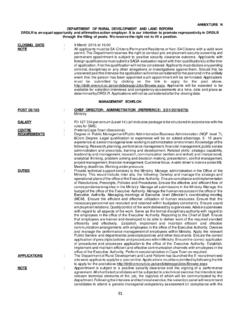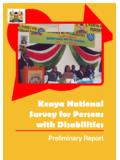Transcription of Success stories on information and communication ...
1 Success stories ON. information AND. communication technologies . FOR agriculture AND. rural development . Second edition Success stories on information and communication technologies for agriculture and rural development IX. Success stories on information and communication technologies for agriculture and rural development Success stories ON. information AND. communication technologies . FOR agriculture AND. rural development . Second edition Edited by Gerard Sylvester Regional Office for Asia and the Pacific Food and agriculture Organization of the United Nations Bangkok, 2017. II. Ghosh Nimai Chandra III. Contents Foreword VII.. Acknowledgements VIII.. Acronyms and abbreviations IX.. Introduction.
2 1. Case Study 1: Digital Green: Leveraging social networks for agricultural .. 3. extension Case Study 2: e-Krishok: Making ICT work for farmers a 360-degree ICT-enabled solution to empower farmers .. 17. Case Study 3: Adapting consumer technology to combat illegal fishing in .. 27. Timor-Leste Case Study 4: Mobile GAP Assessment System: New technology for family farms involved in quality assurance schemes .. 37. Case Study 5: The revolutionary PRIDE model by mKRISHI empow- ering farmers to live with dignity .. 55. Case Study 6: Mobile Market information Service: A pilot project of ICT use for smallholder farmers in Papua New Guinea .. 69. Case Study 7: Nano Ganesh a revolutionary ICT tool for farm irrigation.
3 79. IV. Figures 1. Mr Narshingh Lal, an orange farmer, proudly showing the orange trees he planted after watching the video from Digital 2. A local video production team in the process of creating a video using local 3. A vibrant discussion amongst the community, following a video screening in 4. Improved social status a group of empowered women farmers with Ms Pinky Devi (centre)..12. 5. The e-Krishok 6. e-Krishok 7. Farmbook's administration 8. Farmbook validation 9. Mr Md. Awal and his tomato 10. Farmer consulting with the BIID 11. Mr Md. Sadir Udding Pradhan in his lychee 12. A type of fishing craft commonly used around 13. A fisher with a 14. One button to report IUU, one for 15. Data from the PLBs can be tracked 16.
4 Fishers learn to use the 17. Fisheries inspectors equipped with PLBs aboard a commercial fishing 18. A local fisher brings home his 19. The Q' mark on an agricultural product certified by the Department of 20. Samkha village, representative of family farms in remote areas of 21. Wild fire, flash floods and drought resulting from human activity upset the natural 22. Ms Srinuan Wongtrkul acts as a community information 23. Before (2005, left) and now (right), Samkha reservoir and a check dam network have rejuvenated the 24. Rice camp organized by RMUTL and NECTEC in July, 25. Students of Samkha community as IT 26. Home page of the Mobile GAP Assessment 27. CBs and internal auditors learning together for system 28.
5 Workflow of the Mobile GAP Assessment 29. Screenshot of the GAP-01 form. Farm and farmer's registration 30. Screenshot of the GAP-02 form. Farm data input form for the traceability 31. Screenshot of the GAP-03 form on Android devices. 32. Screenshot of the GAP-04 form on Android devices. Recommendations to improve production based on certification 33. Components of the 34. Ms Nari Inmapan with her quality rice products for sale; a pioneer group of internal auditors trained on system V. 35. Conventional PRIDE 36. The impact of PRIDE empowered with the mKRISHI 37. Interactions among various mKRISHI 38. The CROPS 39. CHPCL company 40. The TCS mKRISHI team's field training for PRIDE farmers (vermicomposting).
6 61. 41. Capacity building flow 42. Linkages 43. TCS's expansion 44. Mobile phone screen with composed message for 45. Map indicating the urban 46. A farmer controlling his pump by mobile 47. Night visits to a water 48. Nano Ganesh flow 49. Nano Ganesh operation 50. Nano Ganesh C with a mobile 51. A local village electrician is vital for ICT implementation in 52. Precise irrigation 53. Advocacy of ICT at rural 54. Analytics of water pumps Boxes 1. A farmer's 4. 2. A perspective from a community 42. 3. A farmer who learned how to use technology with 45. 4. A software 46. 5. System 51. Tables 1. Crop type, code units and 2. Steps used in creating SMS to obtain market 3. Nano Ganesh C product VI.
7 Min Zaw VII. Foreword agriculture has undergone many transformations over thousands of years. Humanity has moved from a society of hunter-gatherers to an agrarian community and then to one where agriculture is handled as an industry, yet still primarily supported at the source by smallholder family farms. While machines have, largely, replaced the manual plough, modern technology, or e- agriculture applications, hold out great promise as the next transformation in this sector. As we know, the task of producing food for more than seven billion people is not an easy one. This is further compounded by difficulties posed by climate change, competition for increasingly scarce resources, limited availability of arable land, disease and pest infestations, food loss and waste among others.
8 These challenges are immense for smallholder farmers and family farmers. There are more than 500 million family farms in the world. They range from smallholders and medium scale operations, to peasants, indigenous peoples, traditional communities, fisher folk, pastoralists and many other groups worldwide who rely on the land and the seas for subsistence. The growth of information and communication technologies , or ICTs, over the last de- cade has been phenomenal. From 2G/3G connectivity, we are now in a phase where we discuss sensor networks, machine-to-machine (M2M) communication , Internet of Things (IoTs) and Big Data. These developments should be harnessed in an affordable way to benefit the majority of small holders.
9 If a simple SMS message can alert the farmer or fisher indeed alert the whole community about important information , then this is a major step in the right direction and it benefits everyone, from producers to consumers. information and communication technologies can transform lives and improve livelihoods more so for people involved in agriculture and allied activities. ICTs can also increase access to financial services for rural communities, helping to secure sav- ings, find affordable insurance and tools to better manage risk. ICTs also widen the reach of local communities, including women and youth, and provide newer business opportunities thereby enhancing livelihoods. The following pages document a collection of case studies, originally printed in 2015, and highlight some of the promising uses of ICT in the agricultural and rural domains.
10 Going forward, FAO, together with our partners, will continue to identify and promote sustainable and scalable ICT solutions for the benefit of all. Dr Kundhavi Kadiresan Assistant Director-General and Regional Representative FAO Regional Office for Asia and the Pacific VIII. A cknowledgements This is the second edition of this publication, previously released in 2015. Together with the countries, organizations and individuals acknowledged in the first edition, the support and guidance of the current FAO Assistant Director-General and Regional Representative for Asia and the Pacific, Dr Kundhavi Kadiresan is kindly acknowledged. Gerard Sylvester Regional Knowledge and information Management Officer FAO Regional Office for Asia and the Pacific IX.














